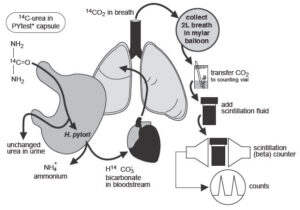Helicobacter pylori (breath)
Helicobacter pylori bacteria breaks down the urea in your stomach and releases extra carbon dioxide in your breath. This test can detect an H. pylori infection by looking at the difference in carbon dioxide levels in your first and second breath samples.

Your doctor will prescribe you the H. pylori breath test due to the following reasons:
- If you have an ulcer in your stomach or upper small intestine
- If you had an ulcer in the past and were never tested
- If you were already diagnosed with pylori and are being retested to see if treatment was effective
There are two possible results for the test:
- You will be tested positive for H. pylori if the amount of CO2 is greater in your second sample compared to your first sample. This means that you have the mentioned bacteria in your stomach.
- You will be tested negative for H. pylori if there’s no difference between samples. This means that you do not have bacteria in your stomach.
Figure 1: Principle of Urea Breath Test (2)
In people without a history of gastrectomy and those without current antibiotics or proton pump inhibitors, urea breath tests had high diagnostic accuracy. In contrast, serology and stool antigen tests were less accurate for diagnosing Helicobacter pylori infection. (1)
References:
- Best, L. M., Takwoingi, Y., Siddique, S., Selladurai, A., Gandhi, A., Low, B., Yaghoobi, M., & Gurusamy, K. S. (2018). Non-invasive diagnostic tests for Helicobacter pylori infection. The Cochrane database of systematic reviews, 3(3), CD012080. https://doi.org/10.1002/14651858.CD012080.pub2
- figure from http://miccom/wp-content/uploads/2016/10/Urea-Breathe-Test.jpg

